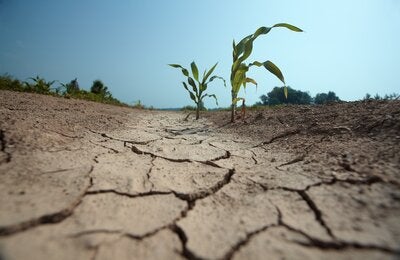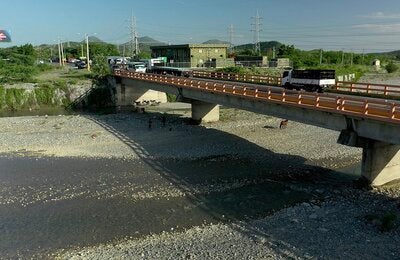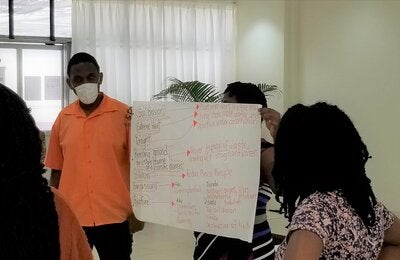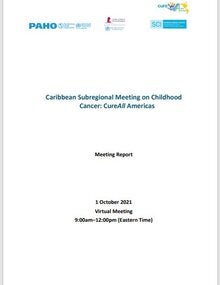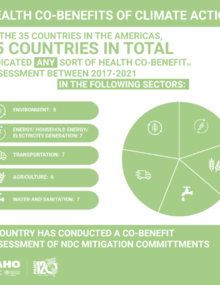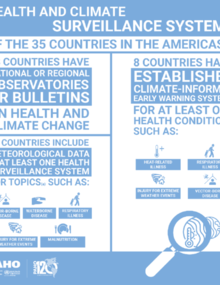To reduce overall vulnerabilities and ensure that health systems are resilient to the impacts of climate change, PAHO/WHO and member states are implementing an agenda of seven interconnected core areas as shown in the graphic below. Each core area spans important aspects that health systems must address and strengthen to anticipate, prepare for, and respond to climate threats.
Health and Climate Change Agenda
Climate Resilient Health Systems can be strengthened by:
Overview of Impacts and Advances
Climate Change and Health in the Americas
REFERENCES
1. Zhao Q, Guo Y, Ye T, Gasparrini A, Tong S, Overcenco A, Urban A, Schneider A, Entezari A, Vicedo-Cabrera AM, Zanobetti A. Global, regional, and national burden of mortality associated with non-optimal ambient temperatures from 2000 to 2019: a three-stage modelling study. The Lancet Planetary Health. 2021 Jul 1;5(7):e415-25.
2. Pan American Health Organization / World Health Organization. Epidemiological Update: Dengue. 7 February 2020, Washington, D.C. PAHO / WHO 2020.
3. Health Care Without Harm. 2019. Health Care’s Climate Footprint: How the health sector contributes to the global climate crisis and opportunities for action. September 2019.
4. Ryan E, Wakefield J, Luthen S. Born into the climate crisis. Save the Children. September 2021.
5. Knutson T, Camargo SJ, Chan JC, Emanuel K, Ho CH, Kossin J, Mohapatra M, Satoh M, Sugi M, Walsh K, Wu L. Tropical cyclones and climate change assessment: Part II: Projected response to anthropogenic warming. Bulletin of the American Meteorological Society. 2020 Mar 1;101(3):E303-22.
FOOTNOTES
a. Countries’ 2021 WHO survey data was used when available. 2017 WHO survey data was used for the following countries: Saint Vincent and the Grenadines, Mexico, Panama, Chile, Ecuador, and Venezuela.
b. Countries’ most recent NDC submission to the UNFCCC was used for this information.
c. Countries’ 2021 WHO survey data was used when available. 2018 WHO survey data was used for Antigua and Barbuda, Honduras, Mexico, Chile, Paraguay, and Venezuela.
d. Countries’ 2021 WHO survey data was used when available. 2018 WHO survey data was used for Antigua and Barbuda and Paraguay. 2017 WHO survey data was used for Saint Vincent and the Grenadines and Panama.
e. Countries 2018 WHO survey data was used for this figure.
Governance and Institutional Structures
Governance and Institutional Structures consists of empowering health sectors to engage in national climate change committees and convene technical and high-level structures on health and climate change with stakeholders and other sectors.
Footnotes:
a. Countries’ 2021 WHO survey data was used when available. 2017 survey data was used for the following countries: Saint Vincent and the Grenadines, Mexico, Panama, Chile, Ecuador, and Venezuela
Planning and National Documents
Planning and National Documents consists of developing health inclusive NDCs, health and climate change vulnerability and adaptation assessments (V&As), Health National Adaptation Plans (H-NAPs), PAHO/WHO-UNFCCC country profiles, subregional (Caribbean, Central America, South America) action plans on health and climate change.
Footnotes:
a. This consist of countries’ most recent NDC submission to the UNFCCC.
Health Infrastructure and Services
Health Infrastructure and Services consists of assessing and transforming health infrastructure to make them resilient and operational during and after climate-related events, and using greener technologies.
References:
1. Health Care Without Harm. 2019. Health Care’s Climate Footprint: How the health sector contributes to the global climate crisis and opportunities for action. September 2019.
Footnotes:
a. Assessing the environmental sustainability of health care facilities refers to assessing the environmental footprint of a health care facility with the aim to optimize the use of resources and minimizing the release of wastes while protecting and improving the health of their communities.
b. Measures to improve climate resilience of health infrastructure consist of: Updated building/planning codes for health facilities; contingency plans in place to ensure access and evacuation routes to health facilities during extreme events; Critical infrastructure/technologies have been equipped o operate during disruptions to energy or utility supplies; Communication systems are equipped to operate when there are disruptions to energy, utility supplies or network; Water supplies and sanitation services will be available during extreme events; Laboratories are equipped to function during extreme events; Pharmaceutical warehouses are in disaster safe zones; Ambulatory services are in disaster save zones.
Health and Climate Surveillance Systems
Health and Climate Surveillance Systems consists of developing and implementing integrated surveillance observatories and early warning systems for climate sensitive diseases and conditions.
Footnotes:
a. Other health topics included: Zoonoses; Impacts on health care facilities; Mental and psychosocial health; and Noncommunicable disease.
b. Other health conditions included: Malnutrition; Mental and psychosocial illness; Noncommunicable disease; Zoonoses, and Impacts on health care facilities.
Health Co-Benefits of Climate Action
Health Co-benefits of Climate Action refers to promoting and measuring health co-benefits of intersectoral mitigation actions with tools such as CarbonH, AirQ+, HEAT, and GreenUR.
Footnotes:
a. Health co-benefits are defined as positive effects that a policy or measure aimed at one objective might have on other objectives, thereby increasing the total benefits for society or the environment.
Research and Capacity Building
Research and Capacity Building refers to promoting increased health and climate change research and capacity building through workshops and courses on climate change and health, on-site and at PAHO’s virtual campus.
Footnotes:
a. This number is out of 26 countries that answered the 2021 survey.
b. This number is out of 25 countries that answered the 2018 survey.
c. Other priority topics included: Heat-related illness (11); Noncommunicable Diseases and Climate Change (9); Allergies and Climate Change (8); and Mental and Psychosocial Health and Climate Change (7)
Health and Climate Finance
Health and Climate Finance consists of ensuring that the health sector has financial means to take action on climate change through increased participation in funding proposal development and engagement with donors/funding partners.
References:
1. COP24 special report: health and climate change. Geneva: World Health Organization; 2018.
Footnotes:
a. Countries’ 2021 WHO survey data was used when available. 2018 survey data was used for Antigua and Barbuda and Paraguay. 2017 survey data was used for Saint Vincent and the Grenadines and Panama.
Related links
- PAHO Health topic: Climate Change and Health
- PAHO Health topic: Environmental Determinants of Health
- PAHO Health topic: Air Quality





